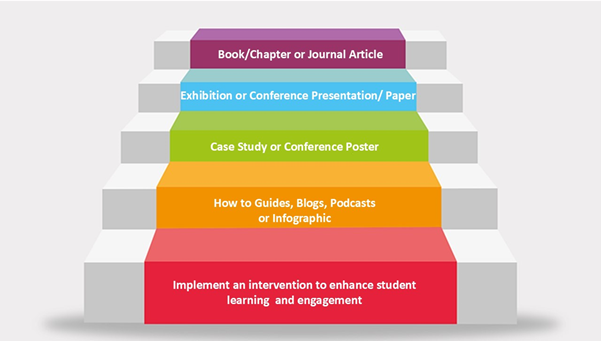- Scholarship of Teaching and Learning /
- Blog /
- SoTL Staircase
SoTL Staircase
Sue Beckingham
Sheffield Hallam University
The visual staircase represents how an educator can gradually build confidence in the Scholarship of Teaching and Learning (SoTL) by engaging in different forms of dissemination. Each step not only enhances the impact of the intervention but also aims to foster professional growth and confidence in SoTL.
By implementing an intervention to enhance student learning and engagement there is much to be learned. Whilst it may be hoped the intervention brings positive outcomes, it is also equally important to capture when it doesn’t and to reflect on what might have been done differently. Reflecting on our practice and sharing this with peers is a valuable discussion to have and can result in useful ways to enhance student learning and engagement which can be of benefit to others as well as our own practice.
Felten (2013) provides five important principles of good practice in SoTL. There are: 1. inquiry focused on student learning, 2. grounded in context, 3. methodologically sound, 4. conducted in partnership with students, and 5. appropriately public. We have all likely to have considered the question “how can I improve/enhance” some aspect of our teaching practice. This may have been done informally with conversations with students but not shared further. The SoTL staircase aims to capture further steps that might be taken so that not only can these insights be openly shared, but we can also involve students as partners (Healey et al, 2014; Cook-Sather et al, 2014). These SoTL outputs can then be built upon by others and have the potential to extend disciplinary contexts (Huber and Morreale, 2002).

Figure 1: The SoTL Staircase
Below are some of the key benefits of the SoTL staircase:
1. Sharing Outcomes Informally (Conversations with Peers)
Benefits:
- Provides a low-stakes way to discuss ideas and gain immediate feedback.
- Encourages peer validation, which helps build confidence in the value of the intervention.
- Supports informal reflection, refining thoughts before committing to written outputs.
- Helps create networks of like-minded colleagues, fostering collaborative communities of practice.
2. Creating How-To Guides, Blog Posts, Podcasts, or Infographics
Benefits:
- Helps in translating complex ideas into accessible formats for different audiences.
- Encourages early confidence in writing that is openly shared.
- Allows experimentation with different communication styles and platforms.
- Broadens reach beyond immediate colleagues, expanding the audience for the intervention.
- Encourages engagement with digital scholarship, an increasingly important skill.
3. Developing a Case Study or Conference Poster
Benefits:
- Requires a more structured approach to explaining the intervention, strengthening clarity.
- Allows for peer review and external validation, building credibility.
- Encourages concise storytelling, an essential skill for academic writing and presentations.
- Provides a steppingstone towards more formal research outputs.
- Encourages confidence in discussing the intervention in semi-formal academic spaces.
4. Presenting at a Conference (Exhibition, Oral Presentation, or Paper)
Benefits:
- Enhances verbal communication skills and ability to respond to academic critique.
- Provides constructive feedback from experts, helping refine ideas further.
- Builds academic presence and reputation within the SoTL community.
- Strengthens confidence in public speaking and articulating pedagogical approaches.
- May lead to collaborations or invitations to contribute to further scholarly work.
5. Writing a Book, Book Chapter, or Journal Article
Benefits:
- Demonstrates depth of scholarship and engagement with existing literature.
- Contributes to institutional and disciplinary knowledge, positioning the author as an expert.
- Requires critical reflection, strengthening the ability to evaluate and articulate findings.
- Helps in career progression, particularly for those seeking promotion or research recognition, and may contribute to the REF.
- Provides a sense of achievement and authority in SoTL, reinforcing long-term confidence.
Each step demonstrates progressive exposure to different levels of academic engagement. It aims to encourage the value of both informal sharing to structured scholarly communication, providing opportunities for peer validation and constructive critique.
Sue Beckingham is an Associate Professor Teaching & Learning in the College or Business, Technology and Engineering.
References
Cook Sather, A., Bovill, C. and Felten, P. (2014) Engaging Students as Partners in Learning and Teaching: A Guide for Faculty. Jossey Bass.
Felten, P. (2013). Principles of good practice in SoTL. Teaching & Learning Inquiry: The ISSOTL Journal, 1(1), 121–125. https://doi.org/10.2979/teachlearninqu.1.1.121
Huber, M.T., and Morreale, S.P. (Eds.). (2002). Disciplinary Styles in the Scholarship of Teaching and Learning: Exploring Common Ground 1st ed. Routledge.
Healey, M., Flint, A. & Harrington, K. (2014) Engagement through partnership: Students as partners in learning and teaching in higher education. AdvanceHE. https://www.advance-he.ac.uk/knowledge-hub/engagement-through-partnership-students-partners-learning-and-teaching-higher